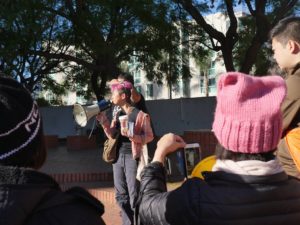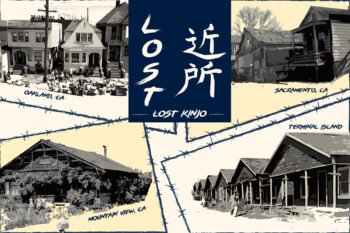
By David Monkawa
Progressive Asian Network for Action
The LA Woman’s March Inc. turned out an impressive 750,000 people! It was inspirational and I was proud of being in a contingent of about 110 people initiated by the “Nikkei Progressives”. (Nikkei means the Japanese diaspora, such as immigrants in the US and their descendants). The ethnic composition of the group was about 60% all Nikkei the rest bi-racial Asian, Chinese, Korean, Filipino and other non-Asian people.
We contacted the Women’s March Inc. to ask if we could speak but there was no response so we held our own mini-rally. The emcees introduced a Japanese immigrant woman who spoke out against US militarism in Okinawa and a Filipino women’s group GABRIELA speaker also talked about US military crimes against women.
The Women’s March Inc. organizers did a good job including many “people of color” (POC) on stage, about 21 out of 28. After the March I saw a video of the program, since you couldn’t get near the stage. Viola Davis stole the show. She disclosed that she was “me too” and overcame poverty to become a famous actor. She said that African American and Hispanic women are more likely to be raped than White women and revealed how human trafficking victims are 70% women. I wished she would have said that most of the billions made from human trafficking came from just 19% of those trafficked for sex from the Asia-Pacific region. But it was a good speech anyway.
In LA County, Latinos are 48%, Whites-28%, APIs including Native Hawaiians-16%, African American-10%.* There was a big disparity between what LA County looks like and the racial composition of the March which appeared to be about half White. On the other hand, deep Blue cities such as Los Angeles, San Francisco and Oakland had a turnout of 10 to 16% of the population of the city participating in the March, which was proportionately better than major cities in the Midwest and Red States with a March turnout of 1% or less of the city’s population.
LATEST STORIES

How could the LA March gain more POC participation? Some grassroots POC leaders believed the Women’s March Inc. organizers were not sensitive to their issues, such as the aforementioned problems of US militarism in Asia, abusive treatment by police or ICE agents, or the ongoing evictions in Boyle Heights and Chinatown. Not that these issues were more important than “women’s issues” but not as immediately urgent. They felt the organizers didn’t reach out to working class communities and that a small unknown group did the planning. Some good points. Several groups are planning a Women’s March close to International Women’s Day on March 3rd 2018.
In defense of the Women’s March Inc., they did pay attention to “optics”. The speakers, people holding the lead banner and monitors were very diverse, roles most visible on camera. There were no major incidents except for a few Nazis who squeaked while being drowned out in a sea of chants like, “No-Trump, No-KKK, No-fascist USA!”
Broader participation may be built next time if; there were more leaders / speakers who were typical working women like secretaries, nurses and K-12 teachers involved in the planning and outreach, in addition to movie stars, politicians and executives of non-profits. Outreaching to communities like the Jordan Downs or Maravilla housing projects. Maybe offer one-day train or bus passes with distribution of bi-lingual flyers before the event with PR in ethnic media. Same with areas like Wilmington and Carson where industrial pollution impacts everyone including major Filipino and Cambodian communities.
Nationally, the leaders of the Women’s March Inc. and “March On” could work closer. March On is a network of women’s organizations in Red states that wants their energy directed to electing local candidates like Doug Jones over sexual predator Roy Moore in Alabama. They believe that the Woman’s March Inc., headquartered in New York, share the same values but have a different culture and emphasis.
LA County is the Asian American capitol of the US with 400,000 Chinese, 375,000 Filipino 230,000 Korean, and 138,000 Japanese*. Many individual Asian Pacific Islanders (API) marched behind the banner they most passionately backed such as being LGBTQ, Medicare-for-All or immigrant’s rights but not behind a banner of their own API community. For many reasons the political concept of “Asian American-ness” faded at the mass movement level since the 1970s, but appears to be making a modest resurgence.

Understanding our histories will promote stronger ties among APIs as well. Japanese Americans (JAs) were the largest Asian group in the US for half a century. Many entered mainstream politics disproportionate to our numbers and won elected offices. This was also reflected in the Asian American movement against the Vietnam War, for equality and ethnic studies on campuses. It began to change when the US relaxed immigration laws in 1965. Later with US-China normalization, Chinese immigration soared. Another factor was the legacy of US involvement in wars and later occupation of the Philippines, Korea and Vietnam. New immigrants from all these countries eclipsed the JA population, which fell to the sixth largest in the US.
JAs overcame the concentration camps and post-war racism. We participated in and benefitted from the Black Power and civil rights movements and built many community institutions and social service non-profits. The new majority of API immigrants in LA are many times larger and are “catching up” to establishing resources like museums, community centers & art and culture venues in much tougher times than 20 years ago.
The legacy of Japanese militarism and the occupation of 21 nations in the Asia-Pacific region during WW2 is another factor. Some APIs are aware of the atrocities committed but too many JAs remain uninformed or unwilling to discuss these issues without which mutual respect and unity will be difficult to attain. It will help our own families and our children to understand their multi-cultural heritage due to the intermarriage between many APIs.
Uniting the API communities is a hard job but Trumps election has smoothed the road because we all share a passionate goal of defeating his views. Nothing forges unity as sharing the same foxhole battling White supremacy and fascism. That’s the “easy” part. The challenge is the handling of contradictions among our own people and engaging in open, above board dialogue while keeping our focus on the real threats.
AsAmNews has Asian America in its heart. We’re an all-volunteer effort of dedicated staff and interns. Check out our Facebook page and our Twitter feed, Please consider interning, joining our staff or submitting a story for consideration.








RE: Asian American group held AAPI Rally at Women’s March: Please let me know how I can be notified of similar efforts/gatherings in the future. I attended both LA marches was disappointed that I didn’t see more Asians and other POC.